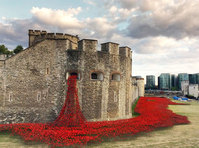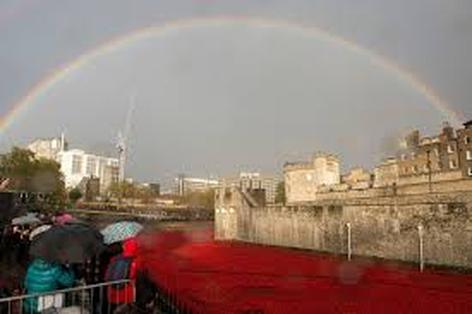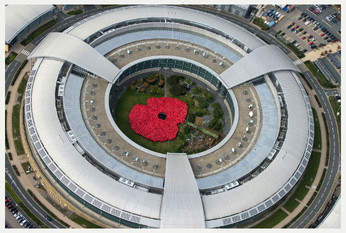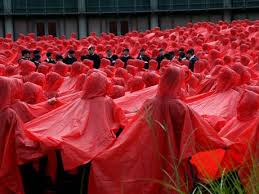So it has been with the centenary of the Great War and the Tower of London poppies.
The photograph above is of Crawford Butler planting the first of Paul Cummins's ceramic poppies on July 17. You are unlikely to have seen it in print, but you can read the Royal British Legion's press release from the day here.

Newspapers reported, as they have done repeatedly since, that there would eventually be 888,246 poppies to represent the British and colonial dead of that war.
The memorial, which was brought into being through a collaboration between Cummins, the designer Tom Piper, Historic Royal Palaces and the Royal British Legion, would take more than three months to complete, with the last poppy being planted today - Armistice Day. The work would then be dismantled and the flowers, which were being offered for sale for £25 each, sent to their new owners.

This year's Tower team may not have expected their efforts to be quite as widely appreciated as it has been, but they seem to have had a fair idea - the figure of four million visitors first appeared weeks ago and has remained constant, though how anyone can put a number on people in a public place over a three-month period heaven knows.
As the installation grew and the time available to look at it shrunk, it was inevitable that a chorus would sing out and call for the poppies to stay forever. This was totally to misunderstand the premise of the artwork, whose life was intentionally brief - as were those of the men it honours - and transient - as were the poppies that bloomed on Flanders fields the year after the ceasefire.
There were also practicalities. Ceramics, like real poppies, don't like frost. They wouldn't survive the winter and, unlike the real-life inspiration, they would not reappear next year.
There was also the small fact that they had been sold. Charities whose task is to support the families of the fallen and those injured in the service of their country had come to count on the funds so raised. Were we to put aside the needs of the bereaved and wounded so that we could have a day out to swap Grandpa stories over a picnic?
This week we were told that parts of the installation had been granted a reprieve: the frames of flowers that flow from the window and across the drawbridge would stay put until the end of the month and then go on tour. Rejoice, rejoice! as Mrs Thatcher would have instructed.

Nigel Farage turned up sporting a giant poppy on his cashmere overcoat at the beginning of this week and was so moved that he had to turn away so that the cameras could capture his tears.
David Cameron, who had allowed himself a Blair-like populist comment amid the faux outrage over Jonathan Jones's Guardian blog, was there with Samantha yesterday, looking suitably pious as they planted their poppies. He also apparently congratulated the Evening Standard on its one-day "campaign".
Now, far be it from SubScribe to pour antifreeze into the champagne flutes, but can we be sensible for a moment? We're in the mood for looking back, so let's recall those primary school arithmetic problems and apply them to this situation:
If it takes 8,000 volunteers three months to assemble and plant 888,246 poppies, how long will it take a similar number of volunteers to pick them and pack them away ready for cleaning and despatch?
There is no set answer, but you can bet it's not 24 hours. The poppies won't disappear by tomorrow night. The Telegraph suggested last month that it would take a couple of weeks.
In other words, politicians and the Press have delivered to a sentimental public a bonus that it was going to get anyway.
| | |
Yes, many, many of the people in the crowds clamouring for a glimpse of the poppies were there to remember great-grandfathers who died in the war - or husbands, sons and daughters killed in Afghanistan or Iraq.
Equally, many were there just to look at the spectacle, to take selfies to post on Facebook with a bit of doggerel or a soppy caption.
Does that matter? Not a jot if they appreciated the art and it made them think. There's enough nastiness in the world for us to be able to accept a bit of social media syrup.
But what of the politicians and the papers? What is the justification for the bullying of an art critic who dared to express a contrary opinion - especially as he has been almost universally misquoted as describing the poppies as a "Ukip-type memorial". It grieves a former sub to say this, but the "fake, trite, Ukip" stuff was in the headline (maybe, staffing being as it is these days, Jones wrote those too).
We can't expect harassed reporters, leader writers and columnists to look beyond the standfirst and the last par before they comment on what someone has written, so here's some help. What Jonathan Jones actually wrote in a considered article that has attracted 2,500 comments (by no means all unfavourable) was:
The crowds come to remember – but we should not be remembering only our own. It’s the inward-looking mood that lets Ukip thrive.
For the Mail to attack the Guardian is not unexpected, but the Mirror, too, got in on the act this week when it criticised the paper because, alone among the nationals, it does not print a poppy on its titlepiece. For heaven's sake.
The Mirror also has its teeth in the BBC for failing to put the Joss Stone poppy single on its Radio1 and Radio2 playlists. This does seem a churlish decision from a state-funded organisation that is busy promoting its own charity record. But for the "intelligent tabloid" to splash on it one day and do a page lead follow-up saying essentially the same thing the next is a bit heavy-handed.
It is also, sadly, in tune with the tone of the "poppy fascism" that Jon Snow identified eight years ago.
Everyone must bow their heads and honour the dead. We, the Press, will ask questions of those who seek to profit (aka earn a living) from their efforts - but we will not hesitate to surf the waves of patriotism to our own advantage. Four papers have offered "free giant poppy posters" to try to lure readers; the Mail is giving away thousands of unique (oxymoronic) ceramic poppy brooches; the Times and the Mail are promoting luxury cruises, complete with butler service, that set off from Tower Bridge at a cost of between £6,000 and £23,000 per person. The Royal British Legion poppy logo features prominently in the centre of the newspaper ads, along with the promise of a £100 donation for every ticket sold. Corporate generosity knows no bounds.
Those Mail brooches are particularly interesting. Readers have to collect 12 unique (there's that word again) numbers over a fortnight to enter a lottery for one of the 3,000 unique ceramic brooches on offer. The numbers are being printed in the paper every day for 15 days and two must come from Saturday issues. The weekday Mail costs 60p and the Saturday paper 90p, so the reader must spend £7.80 for a chance of obtaining one of these "free" brooches. There is no mention of post and packing.
Should they be unlucky, "thousands more" will be released for sale over the coming weeks at £28. The paper says that it will donate £15 to the RBL for every poppy it gives away and that all profits from the subsequent sales will also go to the legion.
Laudable or opportunist?
Ben Macintyre and Patrick Kidd have written movingly but unsentimentally about today's events for the Times. The Independent yesterday ran an extract from Chris McNab's book about the symbolism of the poppy.
The pictures, too, have been stunning - especially today's of the rainbow. Tomorrow we can expect to see 13-year-old Harry Hayes planting the final flower in the moat.
For all the above caveats, the Tower poppies were - and are - special. So here is an aerial tour to round off this day of peace and remembrance.






 RSS Feed
RSS Feed


